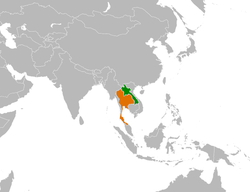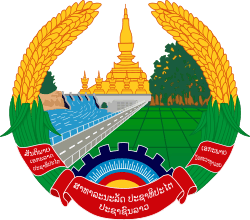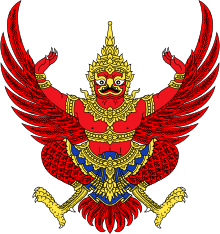Laos–Thailand relations
 | |
Laos |
Thailand |
|---|---|
Laos and Thailand have had bilateral relations for the most part of history. The two countries share a common border, share linguistic and cultural similarities, and have long intertwined histories since the time of their predecessor kingdoms Lan Xang and Ayutthaya in the 15th century. The Lao kingdom of Lan Xang included all of northeastern Thailand as recently as the early 18th century.[1] Thailand's northeastern region, Isan, has particularly strong Lao roots. Linguistically, the inhabitants of Isan, a third of the Thai population, speak the Isan language, a Lao dialect.[1] Both countries have an interest in making the Mekong River a "river of true peace and friendship", as their respective prime ministers called for in 1976.[2]
Diplomatic relations between the modern states were established in 1950, but cross-border cooperation only began at the end of the Cold War.
History
An alarming patrol boat shooting incident occurred in 1980, but this brief encounter was overshadowed by the border disputes and military clashes of 1984 and 1987 in Sainyabuli Province west of the Mekong. These conflicts originated in rival claims to forest resources based on maps from the early days of the French protectorate.[2]
The determination in 1988 of Thai prime minister Chatichai Choonhavan to open up the Indochina market abruptly turned a deadly conflict into a wave of goodwill gestures and business ventures. Kaysone Phomvihan paid an official visit to Bangkok in 1989, his first since the brief 1979 rapprochement with Prime Minister General Kriangsak Chomanand. These gestures were followed by official visits by Princess Maha Chakkri in March 1990 and Crown Prince Maha Wachirolongkon in June 1992. An irony of this process of reacquaintance was the dropping from the Politburo in 1992 of Army Chief of Staff General Sisavath Keobounphanh, who had dealt closely and effectively with the Thai military command in restoring neighborly relations but who apparently was considered by his party colleagues to have indulged in personal gains. Indeed, this corruption of a senior party leader symbolizes the fear among some Laotian leaders that Thailand, with its materialism and business strength and greed, "want to eat us."[2]
Two political issues slowed rapprochement during the 1980s: first, the continuing issue of Laotian migrants and refugees remaining in temporary camps—whom Thailand had no desire to accept as immigrants—and second, Laotian and Hmong resistance groups who used the camps as a base. The Hmong constituted half of the camp dwellers and were expected to avoid repatriation the longest, out of fear of reprisal and hope for national autonomy. Thailand announced in July 1992, however, that Laotian refugees who have not returned home or found third-country resettlement by 1995 will be classified as illegal immigrants and face deportation.[2]
The persistence of a resistance movement since 1975 is attributable to permissive policies on the part of Thailand on behalf of their former Laotian cohorts. With the demise of the Cold War, the motivation to harass the LPDR and its Vietnamese military partners has dwindled. The Ministry of Foreign Affairs will continue to press the Thai military command to live up to its March 1991 agreement to disarm rebels and discourage Laotian sabotage operations. At the same time, Thailand has made clear its unwillingness to assimilate Hmong refugees.[2]
The threat of a return of Vietnamese troops remains as a cautionary note to the Thai military, who prefer to keep Laos as a buffer rather than the military line of contact with the Vietnamese. The Friendship Bridge should open the interior to more foreign trucking and commerce and more openly reveal any foreign military presence in Laos.[2]
In December 2009, Thai soldiers evicted more than 4,000 Hmong asylum seekers from a holding center and forcibly repatriated them to Laos.[3] This action was criticised by Human Rights Watch and the US State Department.[4]
Despite their shared cuisine, language, and border, scholars have noted that anti-communist ideology after the 1950s encouraged the idea of "Thainess", a persistent belief in the superiority all things Thai, leading "the population of central and southern Thailand [to] look to their northern borders with contempt".[1] Thamrongsak Petchlertanan, a historian at Rangsit University, believes that the notion of Thai superiority is rooted in decades of nationalist education in Thai schools. The destruction of Vientiane by the Siamese army in 1778, for instance, is part of this narrative, and has been proudly recounted to generations of Thai children.[1]
Anti-Thai sentiment in Laos
While sharing close historical bond, two nations also witness the upside down on its relations. Since the ancient times, Lao has been against Siamese territorial expansions although both shared the similar religion and there is even a request from Laotian to the French colonial authorities during the colonial times to demand a recovery to Lao lost territory on the Khorat Plateau and to get back the Emerald Buddha from Siam.[5] After achieving independence under a Communist rule, the present Laos government are much pro-towards Vietnam and there is a rejection from the Laotian community who were mainly pro-towards socialism against Thailand influence as a democratic country.[6]
Mutual assistance
In 2012, the Thai government agreed to provide loan assistance to Laos for two projects. The first loan of more than 718 million baht will fund the construction of a 33 km road, that will be built from Phudu checkpoint in Thailand's Uttaradit Province to Parklai District in Sainyabuli Province, Laos, and second loan of more than 84 million Thai baht will be used for the second phase of development of Pakse Airport in Champasak Province.[7]
In October 2011, Lao government presented 1.5 million baht to the Thai government as a gesture of solidarity with the victims of flooding in Thailand's central region.[8]
State visits
Thai Prime Minister Abhisit Vejjajiva visited Laos in December 2010 as part of the 60 year anniversiary of relations between the two countries. He stated that it was "Thai government's policy to encourage the private sector and state enterprises to invest in Lao PDR, while enhancing corporate social responsibility, which renders benefits to local communities and protects the environment at the same time".[9]
On 31 May 2012, Lao Prime Minister Thongsing Thammavong visited his Thai counterpart Yingluck Shinawatra.[7]
See also
References
- 1 2 3 4 Ward, Oliver (2016-12-03). ""They're so Lao": Explaining the Thai sense of superiority". ASEAN Today. Retrieved 21 January 2017.
- 1 2 3 4 5 6 Brown, MacAlister and Joseph J. Zasloff. "Relations with Thailand". Laos: a country study (Andrea Matles Savada, ed). Library of Congress Federal Research Division (July 1994).
- ↑ "Thailand deports thousands of Hmong to Laos". BBC News. 2009-12-28. Retrieved 2016-10-22.
- ↑ Mydans, Seth (2009-12-28). "Thailand Evicts 4,000 Hmong to Laos". New York Times. Retrieved 21 January 2017.
- ↑ Søren Ivarsson (January 2008). Creating Laos: The Making of a Lao Space Between Indochina and Siam, 1860-1945. NIAS Press. pp. 166–. ISBN 978-87-7694-023-2.
- ↑ Keat Gin Ooi (2004). Southeast Asia: A Historical Encyclopedia, from Angkor Wat to East Timor. ABC-CLIO. pp. 772–. ISBN 978-1-57607-770-2.
- 1 2 "Laos, Thailand deepen cooperation" (PDF). Laoembassy.com. Retrieved 2016-10-22.
- ↑ "Lao govt assists Thai flood victims". Asiaone.com. 2011-10-17. Retrieved 2016-10-22.
- ↑ Vejjajiva, Abhisit. "TRANSLATION OF REMARKS BY H.E. MR. ABHISIT VEJJAJIVA, PRIME MINISTER OF THE KINGDOM OF THAILAND, AT THE OFFICIAL INAUGURATION OF NAM THEUN 2 MULTI-PURPOSE PROJECT". Royal Thai Embassy, Singapore. Retrieved 21 January 2017.

